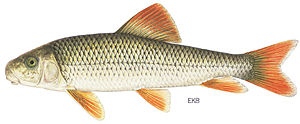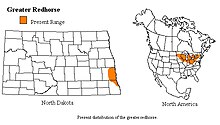Moxostoma valenciennesi
| Moxostoma valenciennesi | ||||||||||||
|---|---|---|---|---|---|---|---|---|---|---|---|---|

Moxostoma valenciennesi |
||||||||||||
| Systematics | ||||||||||||
|
||||||||||||
| Scientific name | ||||||||||||
| Moxostoma valenciennesi | ||||||||||||
| ( Jordan , 1885) |
Moxostoma valenciennesi , engl. Greater Redhorse, belongs to the family of the suction carp .
distribution and habitat
Moxostoma valenciennesi lives at latitudes 49 ° N - 39 ° N in the northern and northeastern United States as well as in the Canadian provinces of Ontario and Québec . It occurs in the Saint Lawrence River , the Great Lakes , Hudson Bay , the Red River of the North and the Mississippi River from Vermont to the Ohio River in Kentucky . Their typical habitat are clear and fast-flowing rivers and cooler lakes. The fish species is extremely sensitive to even the slightest chemical pollution.
description
Moxostoma valenciennesi is one of the larger representatives of the suction carp family. He can normally be 46 centimeters and two kilograms, a maximum of even 80 centimeters with a weight of 5.9 kilograms. They have relatively small eye sockets compared to the large, round skull. Breast and building fins have a reddish golden hue. The back section can have an olive green color. The rear part of the dorsal fin can be slightly concave in juvenile fish and convex in adults. The caudal fin shows a notch, as it is typical for fish that eat their food close to the bottom. Moxostoma valenciennesi differs from other sucker carp species by its bright, rust-red colored caudal fin and the series of black spots of color along the sides.
Way of life
M. valenciennesi feeds benthically, ie it takes food such as insects, detritus, snails and algae from the bottom with its subordinate mouth. Its reproduction begins in early summer, in the months of May and June. To do this, the fish choose an area with moderately flowing water and create a spawning bed in sand or gravel. Then the dairy farmers' territorial fights begin. A Rogner can be surrounded by two milk producers at the same time. With a shaking motion, the egg cells come out of the Rogner and are fertilized by sperm. Then the parent animals move away from the brood nest. The fish larvae hatch after six to eight days and a water temperature of approx. 19 ° C. Their growth rates can vary greatly depending on the location and environmental conditions.
Economic benefit
M. valenciennesi is a "sport fish". Due to its high sensitivity to chemical water pollution, M. valenciennesi can be used as an indicator fish .
Endangerment status
In many US states, M. valenciennesi is considered to be threatened due to its low tolerance to environmental toxins.
Web links
- Greater redhorse Videos, Photos and Facts
- Greater Redhorse Ontogeny - Grand River, Ontario - 1997, 1998 - Images of Greater Redhorse larvae and fry
- Distribution of Moxostoma valenciennesi in Iowa
Notes and individual references
- ↑ lit. trans. "Greater Red Horse"
- ↑ a b c d e Moxostoma valenciennesi on Fishbase.org (English)
